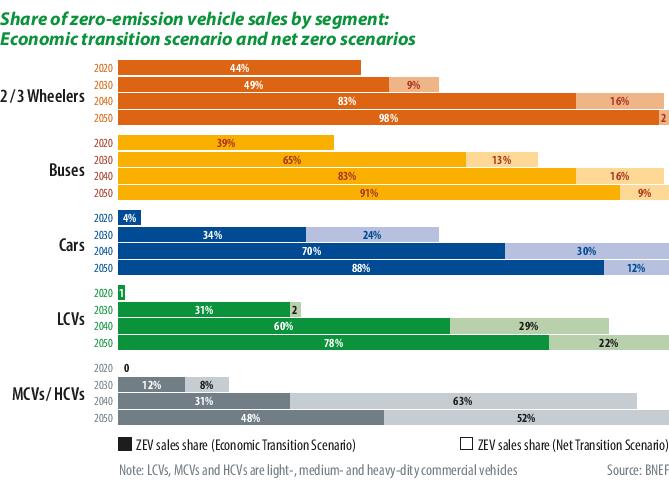You step out of your apartment onto the street. Spring is burgeoning – a faint smell of frost mixed with fresh cut grass from the nearby park reminds you of summer to come. Chatter seeps from a corner café and the tree-lined road is dotted with PV-powered charging points. People walk purposefully, their shoes clip-clopping on the solar-paved path while birds chirp from budding bushes. It’s 8 a.m. on Monday, March 15, 2051 – rush hour – and you’re late for work.
Walking to the nearest designated landing hub, you check the taxi’s location on your hologram device. There’s only a minute to scroll through emails before a whoosh ruffles your hair. You pause and look up to see your ride descending, its rotor blades quietly whirring. The door slides open and you step in, taking a seat by two other passengers, also on their way to the city center.
The electric air taxi ascends. You’ll arrive at your destination in 10 minutes. Beneath, the city sprawls, rooftop PV panels and solar facades glisten in the sun. An electric subway surfaces for a moment to snake its way through the concrete jungle, as electric and hydrogen-powered buses, vans, cars, bikes, and scooters zig-zag their way through the roads below.
From A to Z
The above scenario may seem a sci-fi flight of fancy. But according to BloombergNEF’s (BNEF) “Electric Vehicle Outlook 2021,” if net-zero road transport emissions are to be achieved by 2050, 100% of the world’s road fleet must run on electricity or hydrogen, with almost 60% of new car sales to be zero emission by 2030 (see chart, p. 38).
The analysts place a heavy mantle on transportation, stating that “mobility is at the core of modern civilization.” Evolution in one area, however, often comes with regression in another. And thus, while modern transportation is one of the key building blocks of international business and trade, has widened human communication, and enabled us to place our fingertips on almost every square inch of planet Earth (and increasingly beyond!), it has also contributed to a dangerous carbon footprint, high levels of smog, a growing inequality gap, and the destruction of some of our most fragile environments.
Despite the invention of the electric car in 1830s Scotland, and a 1990s move by U.S.-based General Motors to commercialize them (crushed by the fossil fuel lobby, as depicted in the 2006 documentary, “Who Killed the Electric Car?”), we’ve remained stubbornly focused on burning liquid hydrocarbons to power transportation, to the detriment of our environment and further research into cleaner options.
Driving change
According to Project Drawdown, a nonprofit collaborative established by 200 researchers and advisers in 2013 to model solutions to reverse global warming, transportation accounts for 14% of the world’s greenhouse gas (GHG) emissions. And our appetite is only growing.
Thankfully, we are finally on a greener road to transportation. In its January 2020 report, The road ahead for e-mobility: How OEMs can win consumers and achieve mass-market EV adoption, McKinsey & Company noted that electric vehicle (EV) market penetration increased from 0.9% in 2016 to around 2.5% of the total light-vehicle market in 2019. Europe is said to be the fastest-growing market, although China currently represents the largest by volume.
This year, BNEF reported that there are 12 million passenger EVs, 1 million commercial EVs, and more than 260 million electric two- and three-wheelers on the world’s roads. It predicts passenger EV sales will increase sharply from 3.1 million in 2020 to 14 million in 2025. It attributes Europe’s vehicle CO2 regulations, which include an industry-wide emission target for CO2 of 95 grams per kilometer by 2021, as well as China’s fuel economy regulations and its new-energy vehicle credit system as the primary drivers. This year, policy changes in the United States will have limited impact, say the analysts, but adoption “will start to increase in 2022 and beyond as more compelling local models come to market, particularly in the pick-up truck segment.”
Manufacturers are responding to this trend, with McKinsey reporting that around 400 battery EV (BEV) models are set to enter the market by 2025 across all vehicle segments.
In addition, governments are starting to incentivize consumers. Last year in Germany, for instance, the government increased its EV purchase price subsidy for BEVs from €4,000 to €6,000, and a German EV charging subsidy program, the KfW scheme, pays up to €900 for residential EV charging stations, provided they use renewable electricity. Non-monetary incentives are also being introduced, like partially exempting EVs from city congestion reduction policies.
Complementing these are technological and infrastructure advancements that are not only pushing down prices, but which are also improving issues like driving range and faster charging times.
Beyond passenger cars, BNEF finds that global sales of two- and three-wheelers are already at 44%, while 25% of the existing fleet is said to be electric. Here, China also dominates, although Taiwan, Vietnam and India are seeing rapid uptake. It further calculates that there are already 600,000 e-buses now in operation, representing 39% of new sales and 16% of the global fleet.
“This year marks the first major increase to our EV adoption outlook in the last five years,” write the analysts. “EV sales are surging due to a combination of policy support, improvements in battery technology and cost, more charging infrastructure being built, and new compelling models from automakers. Electrification is also spreading to new segments of road transport, setting the stage for huge changes ahead.”

Evolution vs. regression
This progress is much needed if we are to clean up our mobility act; however, as mentioned earlier, evolution usually carries a cost. And while EVs contain far fewer moving parts than combustion engines, for example – roughly 20 versus 2,000 – their manufacture still produces high CO2 emissions. According to the Financial Times, quoting an unidentified study in China, emissions are 60% higher, primarily because of the batteries.
Batteries are arguably the stickiest point when it comes to e-mobility, with a plethora of news investigations and reports having long documented the working conditions in the Democratic Republic of the Congo where cobalt is mined, for instance, or the energy intensive methods used to extract lithium in places like Chile – topics the UP Initiative addressed in the first quarter of 2020 (see www.pv-magazine.com/up-initiative). What to do with so many batteries at end of life is another hot issue.
E-mobility also requires electricity to operate. According to BNEF, EVs of all types will add 5,000 TWh of electricity demand by 2050 under its Economic Transition Scenario, and 8,500 TWh under its Net Zero Scenario. “In many advanced economies, EVs prevent overall electricity demand from falling,” it says. Thus, the advancement of EV’s must go hand in hand with the greening of our electricity grids.
Infrastructure is another wrinkle to smooth. Charging points are crucial and regulations country specific. As attorney Dirk Voges from Germany-based law firm Weitnauer, and Stefan Zagel, a tax consultant for Ebner Stolz, wrote in an op-ed for pv magazine, “the legal and fiscal issues involved in setting up charging infrastructure can be stumbling blocks for ambitious projects. Among other things, one has to consider charging pole regulation, and energy industry and renewable energy laws.”
Furthermore, which products allow for solar-optimized charging and are national electricity tariffs high enough to make economic sense?
Flights of fancy
There are many companies working to make what may seem like flights of fancy now, a near-future reality. For instance, in Spain, Repsol and Ibil launched the first charging station for EVs using second-life batteries from e-buses this February, while the country’s first e-scooter recharging station powered by solar pavement was commissioned in July by the city council of Sevilla. In France, automation company Sirea has installed a 21 kW recharging station powered by a solar carport and small electrolyzer for self-consumption at its facility in Castres.
Vehicle-to-grid (V2G) technology – where EVs charge from and discharge into the grid – is another promising area, despite the many barriers to overcome, like large-scale commercial deployment, or how vehicle owners should be incentivized to make their vehicles available for V2G.
“With the opportunity to provide storage at huge scale and very low cost, it now comes to the industry stakeholders to overcome these barriers of low customer value and concerns over battery degradation. It remains to be seen whether an effective commercial proposition can be made amongst the web of stakeholders, including auto OEMs, energy suppliers, and flexibility providers … to effectively unlock the value of V2G,” wrote George Hilton, senior analyst for energy storage at IHS Markit, in the August edition of pv magazine (pp. 12-14).
VIPV or vehicle-integrated PV is also starting to gain traction. In a recent interview with pv magazine online, Bonna Newman, program manager for PV and Mobility, Module Technologies at the Netherlands Organization for Applied Scientific Research said that EVs incorporating PV modules on their bodywork or roof have the potential to reach more than 10,000 km per year of pure solar-powered driving and that the modules could have a payback time of just three to four years.
Product innovation is likewise far-reaching. Kenyan startup Solar E-cycles, for example, has developed a solar-powered tricycle targeting access to sustainable mobility and electricity for productive use in rural offgrid communities. The advantages include reduced emissions, a new leasing business model for Kenyans, and expanded household revenue opportunities.
All aboard
Electric air taxis may currently be more of a sci-fi fantasy, although hundreds of companies are said to be working on the concept, with investment bank Morgan Stanley predicting the “urban air mobility” market will be worth $1.5 trillion by 2040. However, there are many working projects already demonstrating the potential to electrify the world’s transportation sectors. There are hurdles to overcome and we must remain alert to the pitfalls that will come with this progress.
Thus, the UP initiative in the first quarter of 2022 will investigate how the growth of e-mobility can complement the renewable energy transition, focusing on solar and energy storage-integrated solutions, products, technology, costs, business models, and political issues. If you want to jump aboard, contact up@pv-magazine.com.
This content is protected by copyright and may not be reused. If you want to cooperate with us and would like to reuse some of our content, please contact: editors@pv-magazine.com.

